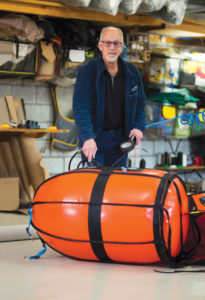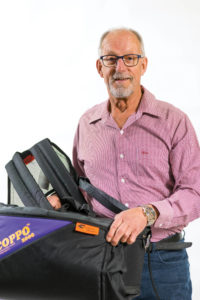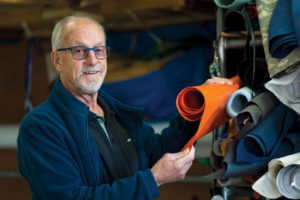
“We keep experimenting with a product until we get it right, which is really what we’re about,” says Bill Coppins, owner and director of W.A. Coppins Ltd. in Motueka, New Zealand. “With jobbing work you’re always competing against someone down the road. So I thought: Let’s get out there and develop our own product that is unique—and get rid of the competition.”
Coppins’ grandfather started the business in 1898, at that time primarily a saddlery shop. But with the advent of the automobile, the shop reinvented itself as a canvas shop, manufacturing products such as tarpaulins, awnings and kiwi picking bags. Coppins’ father eventually took over the business, and in 1964 Bill Coppins decided he wanted to work there full time—against his father’s advice. “School wasn’t doing much for me and I wanted to work [at the family business] but my dad told me to get back to school,” he says. “But I said no, I wanted to work there.”
By the late 1970s, he took charge of the business, which he says was floundering. “I took out a few loans and built a new building—so I knew we had to develop the business in a hurry,” he says. “Even the bank manager said he didn’t know why he had loaned us money. But we proved ourselves in the end.”
Time and motion
The first thing Coppins did after he took over was overhaul the company’s fruit picking bags. “I put more time and motion into them,” he says. “We cut down production costs, brought in new fabric and developed a better product.”
To improve the fruit picking bags, Coppins and his design team set three main goals: to better protect the fruit from bruising, to improve comfort for the pickers, and to create an aesthetically pleasing end product. His team achieved all three. They eliminated the plastic outer lining and replaced it with a high-density foam lined with polyester fabric, made it ergonomically structured to take the load off the pickers’ shoulders, and used a durable black fabric with a striking purple and burnt orange logo.
The team named the resulting bag the Coppo 2000—“Coppo” after Coppins’ father (Coppo was his nickname) and “2000” as a forward-looking nod to the millennium that was approximately eight years away. “We had made the bag completely different from whatever else was in the market and wanted the name to be short and memorable,” he says. “The industry completely changed over to using our bags, and even today we hold about 98 percent of the market share in the kiwi fruit segment.”
The bag’s success has been so complete that when Coppins started looking into updating the bag’s branding, distributors of the bags asked him not to do it. “We wanted to bring the product up to the times with a different color and call it the Coppo 3000,” he says. “But our agents around the country, as well as overseas, told us not to. They said that people come in and either ask for the Coppo 2000 or ‘that bucket with the purple logo.’ So we decided we shouldn’t disturb things when they’re going so well. Instead we just made the odd modification without changing the branding.”
 Of land and sea
Of land and sea
Coppins’ conviction that he needed to design new products to make a success of a small-town fabrication shop led him to consider the needs of both land and sea. “We’re only a small town of 7,500 people, which makes it a bit harder because you’re limited with what you can turn over,” he says. “So early on we developed our sea anchors. A lot of that was through chance—people coming in, saying they wanted drogue-type anchors, very much like the weather vane wind socks at airports. We also made an agricultural hothouse, which was unique in itself in those days.”
The company still sells the hothouse, which is mostly the same today as it was 30 years ago when Coppins and his team designed it. But the sea anchors have been an ongoing design opportunity—one that Coppins fully embraces. “At the moment we’re more of a design and development company rather than a production company,” he says. “We’re really trailblazers in the industry, doing things now with sea anchors that no one thought possible 10 years ago.”
Design and development
The first drogue types of sea anchors the company made were used during the tuna season on New Zealand’s west coast. “It’s fairly rugged out there at times,” Coppins says. “The crew would be 60 miles out to sea and rather than come in every night they used to hang out these drogues to keep the bow into the wind and make the ride easy overnight while the team is sleeping.”
When the squid industry started to take off, Coppins designed a parachute-type anchor. “The drogue-type anchors weren’t sufficient for the squid jiggers,” he says. “They wanted something that would reduce drift, and I thought: Why not a parachute-type anchor? So I designed a parachute that was lighter, bigger and easier to handle—and it reduced the drift a lot more.”
According to Coppins, the development of the parachute anchor is what opened the doors for the company in the sea anchor design and development arena. Soon after, the team designed a sea anchor for yachts in the 40-foot range. “To sail to another country from New Zealand you have to sail at least 1,000 miles,” he says. “At the time we developed the StormFighter™, yachties would meet up with a storm and our sea anchor was the only thing they could hang off the side to keep the bow into the wind. Quite a few people have written to us about how the StormFighter saved their lives and the lives of their crew.”
 When Coppins’ company got its first U.S. Navy contract to develop anchors for a variety of uses, the job required a significant amount of research. “We work with research companies for this type of thing because we’re too small a company to spend the necessary money to develop anchors for some of the largest tanks in
When Coppins’ company got its first U.S. Navy contract to develop anchors for a variety of uses, the job required a significant amount of research. “We work with research companies for this type of thing because we’re too small a company to spend the necessary money to develop anchors for some of the largest tanks in
the world,” he says.
That work led to more work, for both private and government entities. “From there we developed a whole lot of other things,” Coppins says. “Companies come to us for sea anchors for steerage control—for large tankers that have no motor to control their steerage while they’re being towed in storms. We even designed one system to be flown in by helicopter and dropped onto an immobilized ship.”
That product was a particular challenge because of a tight timeline, and finding a way to design the anchor to be strong enough as well as aerodynamic underneath a helicopter. “We had to design to the weaker points of the material,” Coppins says. “It came down to how strong the thread was and cutting the fabric in a way to deliver maximum strength.”
During the design process, Coppins and his team do a lot of modeling and use a local causeway for testing. The team makes a model, goes to the causeway to test it, and takes it back to the shop for slight alterations before returning to the causeway for more testing. “The company we worked with for the Navy call us the MacGyvers,” he says. “They say they come to us with a problem one day and we have it solved by the next morning. And I guess that’s what we’re good at. We see the picture and we know what’s needed and model up.
“None of us have got university degrees,” Coppins says. “We persevere and achieve what we set out to do, and we do it from the other side of the world.”
Every day, 500,000,000 gallons of oil is transported around the world—which means 356,000 kilometers of coastline require protection from oil tanker spills and shipwrecks.
In 2014, a customer asked W.A. Coppins Ltd.’s spin-off company Coppins Sea Anchors Ltd. to design and manufacture a self-contained high-strength sea anchor that could be flown by helicopter at 80 knots to stricken vessels weighing up to 200,000 tons. “The anchor would need to self-deploy, then stabilize and save the vessel, save the crew, protect ecosystems and coastline from damage by oil spillages,” says Bill Coppins.
An added challenge: Coppins and his team had only seven months to complete the project. “There was no let-up until it was completed. We had the mind-set that we would accomplish it successfully—and we did,” he says.
The resulting aerodynamic system contains a 27-meter sea anchor that flies straight with minimum drag on air speed, yet self deploys in the water. It has a rear fin to stabilize the system during flight, but is a recovery buoy upon deployment. The system stops the disabled vessel from drifting, as well as being available as a towline for towing to safety. “Every item used in the system was designed for maximum strength but of the lightest weight,” Coppins says.
The project won an IAA Award of Excellence. “This kind of a project had never been done before but we were confident it could be achieved, and we went to extraordinary lengths to achieve it,” Coppins says.
- Contact other companies who have experience with protecting IP to find out what their experiences were like.
- Make sure you’ve got a lawyer that’s good at IP/contract work.
- Consult export organizations and/or trade associations regarding how IP rights differ from country to country.
- Make sure contracts are signed before showing any designs/developments.
- Develop on a small scale if possible to get a product to a point where it’s working before submitting to clients so you can retain the IP.
How did you market your hothouses to maximize profit and facilitate product development?
We did that mail order because we’re out in the country. It allowed us to keep wholesale and the retail markup—because if you sell through a retailer you’re dictated by them to some extent and your profitability is cut. We took the retail markup and put it back into the development of other products. Basically we looked outside the square in everything we did.
Of all the people who’ve written to tell you about how your Para Sea Anchors have saved their lives, are there any that stand out?
There is one from the West Coast. This man had no fear. He got caught in a storm several years ago, going up to the Pacific Islands in New Zealand, and the wind gauge was gusting to 154 knots. The waves were between 70 and 100 feet. He was on our sea anchor for three days or so and reckons if it wasn’t for our sea anchor, he wouldn’t have survived.
He was using one of our ParaFish™ anchors, which was what all the fishermen used. At that time we were only just developing the StormFighter for yachties but it was a similar design. We make them out of stronger fabric now and have designed the shape a bit differently.
 TEXTILES.ORG
TEXTILES.ORG


